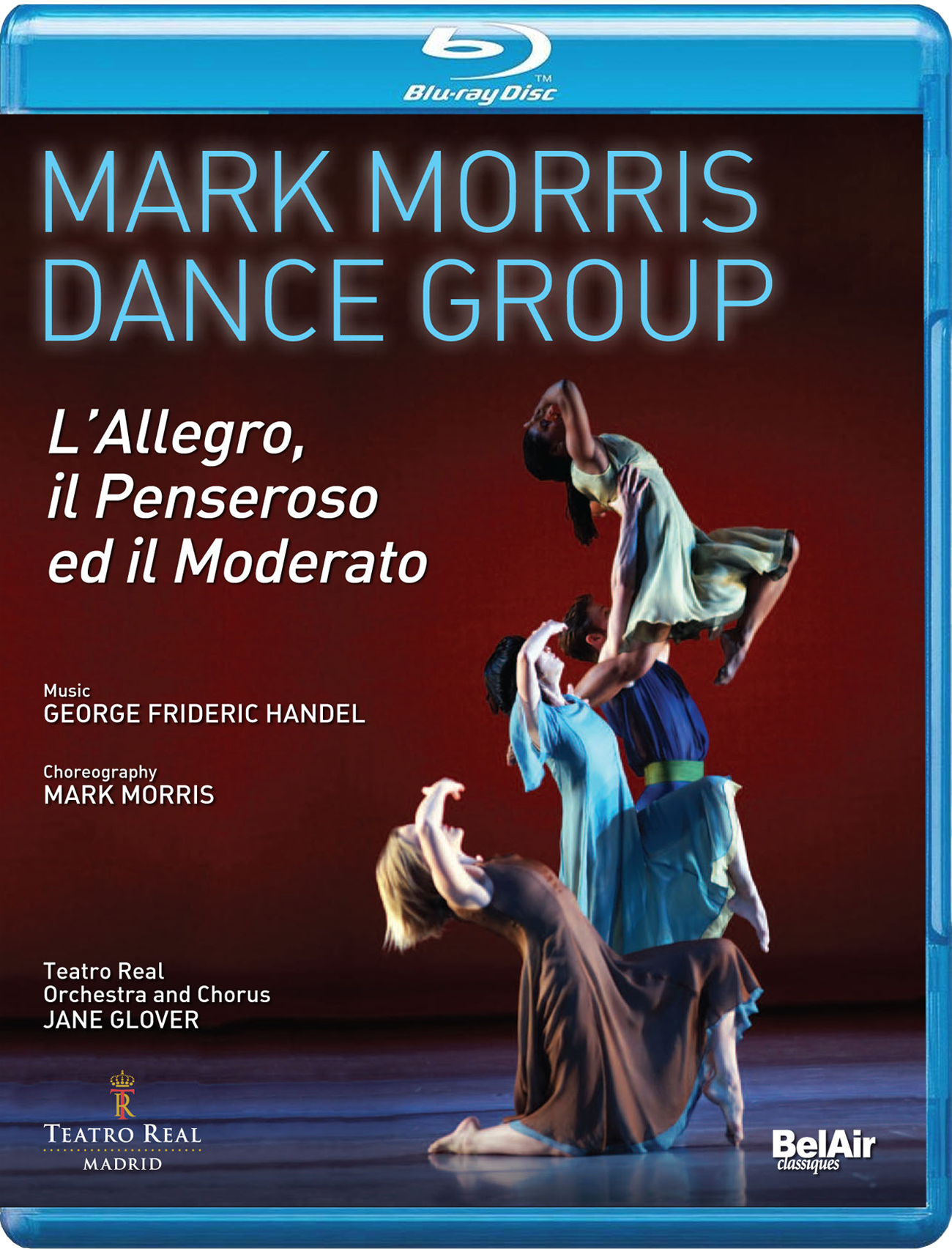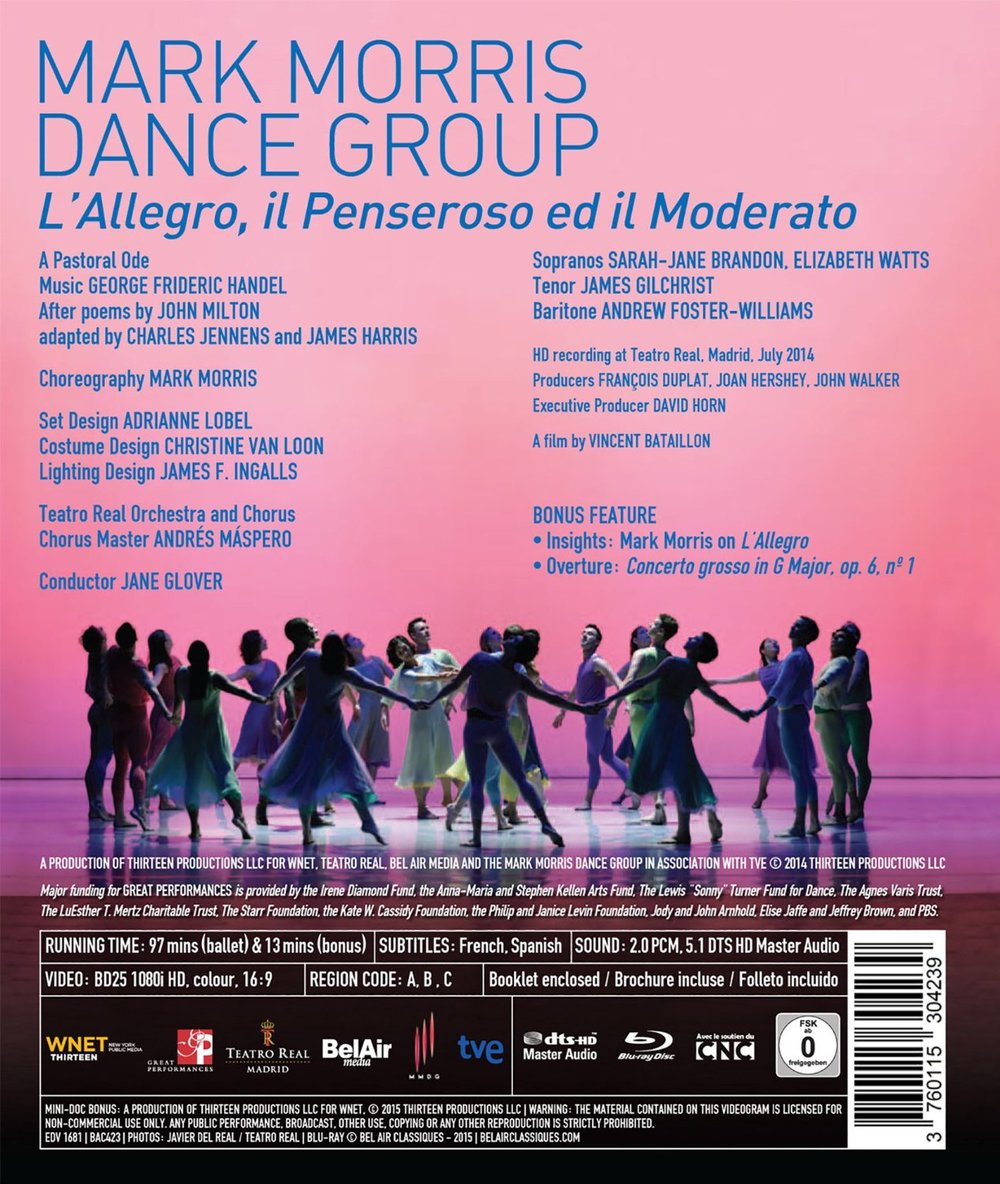

Mark Morris L'Allegro, il Penseroso, ed il Moderato dance work. In 2014, the Mark Morris Dance Group performs, at the Teatro Real in Madrid, the above-named work to Handel's musical ode of the same name, i.e., L'Allegro, il Penseroso, ed il Moderato. Choreography by Mark Morris. Dancers (alphabetical by last names) are Chelsea Lynn Acree, Sam Black, Max Cappelli-King, Brandon Cournay, Rita Donahue, Domingo Estrada, Jr., Jusie Fiorenza, Benjamin Freedman, Lesley Garrison, Lauren Grant, Brian Lawson, Aaron Loux, Laurel Lynch, Stacy Martorana, Claudia Macpherson, Dallas McMurray, Maile Okamura, Brandon Randolph, Billy Smith, Utafumi Takemura, Noah Vinson, Nicholas Wagner, Jenn Weddel, and Michelle Yard. Jane Glover conducts the Orchestra and Chorus of the Teatro Real Madrid (Chorus Master Andrés Máspero). Solo singers are Sarah-Jane Brandon and Elizabeth Watts (sopranos), James Gilchrist (tenor), and Andrew Foster-Williams (baritone). Set design by Adrianne Lobel; costume design by Christine van Loon; lighting design by James F. Ingalls. Directed for TV by Vincent Bataillon; produced by François Duplat, Joan Hershey, John Walker, and David Horn. Released 2015, disc has 5.1 dts-HD Master Audio sound. Grade: A-
The full title of this piece, L'Allegro, il Penseroso, ed il Moderato, might be translated as The Joyful, the Contemplative, and the Typical Man. The starting point for all this was two poems published in 1645 (about 30 years after the death of Shakespeare) by John Milton: L'Allegro (152 lines) and Il Penseroso (176 lines). Probably few people read these eloquent, erudite, and challenging poems today other than candidates for advanced university degrees in English literature. But they were much admired in the past.
In 1740, Handel wanted to use the two poems, which had parallel characteristics, as the basis for a pastoral ode for an orchestra, chorus, and soloists. James Harris helped Handel by slicing the poems into pieces which he then arranged—shish kabob style—into a single poem. Later Charles Jennens added a short third poem about the moderate or typical man. Handel's ode is full of delightful music that is much easier for us to enjoy today than Milton's text full of odd spellings and references to classical mythology.
Mark Morris, just getting started in his career, was commissioned by Gerard Mortier, then head of the Théâtre Royal de la Monnaie in Brussels, Belgium, to write a dance piece based on the Handel ode. The new dance work was premiered in 1988 in Brussels and has been regularly performed since then all over the world. Mortier became artistic director at the Teatro Real in 2008, and he died in March 2014. This recording of L'Allegro, il Penseroso, ed il Moderato was made at an In Memoriam performance of the work 4 months after the death of Mortier. Morris wrote a special note honoring Mortier that is printed in the keepcase booklet.
There are 32 mostly-short dance scenes in Morris's libretto, which are danced to a "selection of arias and recitatives" from Handel's score. Most of the original Milton poetry is retained, but only about 10 lines of the Il Moderato text gets added to the shiskabob. The dance ideas developed by Morris are directly inspired by Handel's music and also generally and indirectly inspired by the text. BelAir provides a separate chapter on the disc for each dance scene and identifies each dance scene with the name Morris gave it. In the early chapters, it's fairly easy to relate the chapter names to something in the text. But at the middle and end of the program, connecting each dance scene to the text gets increasingly more problematical.
Here are the "Three Graces" from Chapter 5 (L'Allegro). Everyone dances barefoot in simple but pretty costumes:
The next two shots are from Chapter 6, "Sage and Holy" (Il Penseroso):
Below is a scene from "Haste Thee Nymph", Chapter 7 (L'Allegro). I think poses like this are considered dance-theater:
The next shot below is from Chapter 8, "Come and Trip It" (L'Allegro). This is inspired by the famous lines: "Come, and trip it as you go, on the light fantastic toe."
The next two shots below are from Chapter 11, "Diet Dances" (Il Penseroso). I think it's hard in dance to depict serious aspects of life such as "contemplation." The girls below are singing at Jove's altar (three girls are behind a scrim.):
And I think the men here are fasting:
The next two shots are from Chapter 12, "Birding", which lasts more than 12 minutes (L'Allegro). Here Handel goes nuts with bird songs from the orchestra and Morris does his best to dream up ways for dancers to act like feathered friends:
Then in Chapter 13 we have "The Hunt" (L'Allegro). In the next shot the girls have formed trees and thorn bushes:
Two foxes run about hiding from the hunters:
Or rather, from the hunters' dogs:
The "Merry Bells" of Chapter 19 (L'Allegro) show, I think, a peasant holiday frolic leading to a mass engagement party or common-law wedding:
Videographer Vince Bataillon mostly shoots whole stage or other long-range shots showing the dancers from head to toe. Here's a rare close-up with dramatic appeal for the home theater audience:
After an intermission and change of costumes, we see a pretty "Ladies' Dance" in Chapter 26 (L'Allegro):
Finally, Il Moderato gets a chance to speak in Chapter 27, the "Walking Duet." The utterly simple formations remind me of a high-school marching band; but with the music of Handel in the background, the effect is strangely mesmerizing:
And here's our old friend Orpheus in Chapter 31 (L'Allegro):
Chapter 32 is the Finale:
There are no stars in this production; all the dancers have an equal input. Everything is simple, stately, serene, and seductive. The music drives every action. There is no hint of expertise, virtuosity, or risk. It all looks so easy; but, of course, it's not. The orchestra sounds nice as do the singers. PQ and SQ are fine, and the restrained and grand-scale videography of Vincent Bataillon will please ballet and dance fans who want to see the whole bodies of the dancers most if not all of the time. This was a very civilized and dignified In Memoriam event for Mr. Mortier.
David Vickers in the 2015 Gramophone Awards issue (page 96) displays astonishingly detailed erudition about the original poetry and the structure of Handel's music, which leads him to criticism of Morris for changing things around! Well, this is a modern dance piece for general audiences—not a concert for experts in early music. Morris would be justified in shuffling Handel's deck after throwing out loser cards. Ethical and philosophical notions can't be expressed in abstract dance except in the most ethereal ways. So Morris gets to pick the music that will help him and ignore the rest. Experts in Milton and Handel are cheerfully invited, but attendance is not required.
My only critique would be that BelAir could have done a better job of packaging this intricate work with text almost as old as Shakespeare, music from age of Bach, and singers off-stage. I would have been so pleased to have subtitles in English! It's hard even for a native English speaker to understand text sung by people you can't see. Non-native-English speakers will be mostly shut out. The text translations into French and Spanish will give some additional customers a rough idea what this is about. But the translation will not allow them to match up the text to dance chapters. If sub-titles were too expensive, perhaps BelAir could have annotated the text in some way to link different parts of the text to the named dance chapters.
Well, BelAir has dropped the baby. Time for a grade. I'll start with an A and reduce that to A- for the sadly inadequate keepcase booklet. If BelAir would provide better consumer guidance to the disc on their website, I'd increase the grade.
OR





















